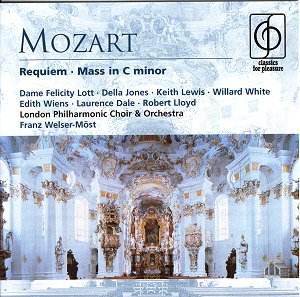Franz Welser-Möst’s period as conductor
of the LPO was widely regarded as a mixed blessing. However, much
of the criticism levelled at him at the time was unfair, not to
say a little stupid. That he is a conductor of real flair and
talent there is little doubt, and this two-disc set is testimony
to that. These are not by any stretch of the imagination ‘period’
performances, for they use a large orchestra playing modern instruments,
and a big, full-throated chorus – the London Philharmonic Choir
on top form. Certainly not to everyone’s taste, then; but of their
kind, they are well worth hearing.
The coupling of Mozart’s two greatest torsos
seems an obvious one, and I was a little surprised to discover
that there didn’t seem to be another one in the current catalogue
(unless, of course, you know different….!). Of the two, the C
minor is probably the more convincing in the form it has come
down to us. The booklet note discusses briefly but lucidly the
mystery surrounding the work’s incompleteness, which is too complex
to go into here. Suffice it to say that the Robbins Landon edition
used here is strict in confining itself to nothing more than those
sections which exists in the autograph, namely the opening Kyrie,
the Gloria, the Credo up to the Et incarnatus,
concluding with the Sanctus, Benedictus and Osannas.
It is an overwhelmingly powerful utterance, and
represents a staggering achievement for a 27 year-old. This performance
gives it the full works, the opening Kyrie very slow
but darkly dramatic, its chromatic complexities drawn out to superb
effect. The one serious weakness in the casting of the otherwise
very fine soloists is the soprano I, Edith Wiens. Despite her
sweet tone, she is too self-indulgent. Listen to the rising triplets,
track 1 after 3:23, for example. Needless to say, Mozart asks
for no fluctuation in the tempo at all, let alone this sort of
huge rubato. Unfortunately, here and in the exquisite Et incarnatus,
Welser-Möst indulges her, and allows the already steady tempo
to drag almost to a halt in places.
The Gloria concludes with a long-note
fugue that is like a large-scale version of the finale of the
Jupiter Symphony. It builds to a majestic peroration, with
the resplendent announcement by the tenors of the inversion of
the fugue subject a memorable moment. Throughout, the performance,
though far from subtle, captures the imagination and energy of
this tantalisingly great work.
Meanwhile, in the Requiem, Felicity Lott
gives an object lesson in Mozart singing - flexible and expressive,
yet also disciplined and restrained where appropriate. Welser-Möst
uses the edition by Franz Beyer, made in 1971. In effect, it’s
not all that different from the Süssmayer, which remains
in essence the version many choirs use even today. But it does
have numerous differences in details of scoring, as well as some
subtle additions in the later stages of the work, e.g. the conclusion
of the two Osanna sections.
The finest music is in the first two movements,
the Requiem aeternam and the Dies irae, and I have
to say Welser-Möst and his forces are riveting in the big
choral/orchestral sections. The opening brings wonderful phrasing
from solo bassoon, with the lugubrious sounds of basset horns
and alto trombone colouring the music to wonderful effect, all
excellently captured by the spacious yet clear recording. The
beginning of the Dies irae has never sounded more dramatic,
and the upper soloists in the Tuba mirum characterise their
music well, though Willard White doesn’t to me sound entirely
at home in this music; compared to Robert Lloyd in the C minor
Mass; he seems to find the breathing problematic, and worries
at the music somewhat. Great singer, but odd choice.
Odd how the human memory works; as the Recordare
began, I found myself recalling the beginning Part 2 of Gerontius;
on the surface, there’s not much in common other than the
key. Yet Mozart here has that sense of effortlessly light movement
that Elgar wished to express, and the performers capture perfectly
the serenity of this sublime music. The Recordare movement,
though deeply felt, is really too slow and romantically inclined
for my taste, and the tempo causes the choir, particularly the
sopranos, some problems in the sustaining of controlled tone in
the top register. On the other hand, the singing of the solo quartet
in the Benedictus is a real joy. Willard White certainly
redeems himself here, with some sensitive ensemble singing.
As I say, not to everyone’s taste; you’ll either
fall for these whole-hearted, large-scale performances, or you’ll
hate them; I fell!
Gwyn Parry-Jones
